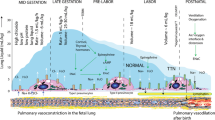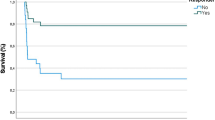Abstract
Objective:
Nitric oxide (NO) is synthesized by NO synthase (NOS), and asymmetric dimethylarginine (ADMA) is an endogenous inhibitor of NOS. We aimed to investigate l-arginine and ADMA levels in transient tachypnea of the newborn (TTN) and their relationship with systolic pulmonary artery pressure (PAP) and disease severity.
Study design:
Infants born at ⩾35 weeks gestational age with clinical signs and chest X-ray findings consistent with TTN were enrolled; controls were recruited at the same time. l-arginine and ADMA levels were measured at 12 to 24 h (first samples) and at 48 to 72 h (second samples). Systolic PAP was evaluated on the second day. Patients were divided according to the duration of tachypnea and designated as group A (duration ⩽72 h) and group B (duration >72 h).
Results:
In the first samples, the ADMA levels were significantly higher in patients with TTN compared with controls (P<0.001). In the second samples, the ADMA levels were significantly higher in group B compared with that in group A (P=0.019). In group A patients, the second ADMA levels were significantly lower compared with that in the first samples (P<0.001), whereas the second ADMA levels remained unchanged compared with the first samples in group B. Systolic PAP values were significantly higher in group B compared with that in group A patients (P=0.033).
Conclusion:
Increased ADMA concentration may reduce NO synthesis, leading to increased PAP and thus longer duration of tachypnea.
This is a preview of subscription content, access via your institution
Access options
Subscribe to this journal
Receive 12 print issues and online access
$259.00 per year
only $21.58 per issue
Buy this article
- Purchase on Springer Link
- Instant access to full article PDF
Prices may be subject to local taxes which are calculated during checkout
Similar content being viewed by others
References
Miller LK, Calenoff L, Boehm JJ, Riedy MJ . Respiratory distress in the newborn. JAMA 1980; 243 (11): 1176–1179.
Gowen CW Jr, Lawson EE, Gingras J, Boucher RC, Gatzy JT, Knowles MR . Electrical potential difference and ion transport across nasal epithelium of term neonates: correlation with mode of delivery, transient tachypnea of the newborn, and respiratory rate. J Pediatr 1988; 113 (1, Part 1): 121–127.
Guglani L, Lakshminrusimha S, Ryan RM . Transient tachypnea of the newborn. Pediatr Rev 2008; 29 (11): e59–e65.
Ramachandrappa A, Jain L . Elective cesarean section: its impact on neonatal respiratory outcome. Clin Perinatol 2008; 35 (2): 373–393.
Crowley MA . Neonatal respiratory disorders. In: Martin RJ, Fanaroff AA, Walsh MC (eds). Fanaroff and Martin’s Neonatal–Perinatal Medicine: Diseases of the Fetus and Infant, 10th edn. Elsevier Mosby: St Louis, MO, USA, 2015, pp 1127–1128.
Moncada S, Palmer RMJ, Higgs EA . Nitric oxide: physiology, pathophysiology, and pharmacology. Pharmacol Rev 1991; 43: 109–142.
Barnes PJ, Belvisi MG . Nitric oxide and lung disease. Thorax 1993; 48 (10): 1034–1043.
Cooke JP . Does ADMA cause endothelial dysfunction? Arterioscler Thromb Vasc Biol 2000; 20 (9): 2032–2037.
Millatt LJ, Whitley GS, Li D, Leiper JM, Siragy HM, Carey RM et al. Evidence of dysregulation of dimethylarginine dimethylaminohydrolase I in Chronic Hypoxia-Induced Pulmonary Hypertension. Circulation 2003; 108: 1493–1498.
Sanli C, Oguz D, Olgunturk R, Tunaoglu FS, Kula S, Pasaoglu H et al. Elevated homocysteine and asymmetric dimethyl arginine levels in pulmonary hypertension associated with congenital heart disease. Pediatr Cardiol 2012; 33 (8): 1323–1331.
Gorenflo M, Zheng C, Werle E, Fiehn W, Ulmer HE . Plasma levels of asymmetrical dimethyl-L-arginine in patients with congenital heart disease and pulmonary hypertension. J Cardiovasc Pharmacol 2001; 37: 489–492.
Bordigato MA, Piva D, Di Gangi IM, Giordana G, Chiandetti L, Philippone M . Asymmetric dimethylarginine in ELBW newborns exposed to chorioamnionitis. Early Hum Dev 2010; 87: 143–145.
Lopez-Alarcon M, Montalvo-Velarde I, Vital-Reyes VS, Hinojosa-Cruz JC, Leanos-Miranda A, Martinez-Basila A . Serial determinations of asymmetric dimethylarginine and homocysteine during pregnancy to predict pre-eclampsia: a longitudinal study. BJOG 2015; 122: 1586–1592.
Sertkaya AC, Kafkasli A, Turkcuoglu I, Karabulut AB . Asymmetric dimethylarginine levels in hyperglycemic gestation. Endocrine 2011; 40: 237–242.
Martin R . Pathophysiology and clinical manifestations of respiratory distress syndrome in the newborn. In: Garcia-Prats JA (ed). UpToDate, Waltham, MA, 2014 (last date accessed 7 November 2014).
Chan KL, Currie PJ, Seward JB, Hagler DJ, Mair DD, Tajik AJ . Comparison of three Doppler ultrasound methods in the prediction of pulmonary artery pressure. J Am Coll Cardiol 1987; 9: 549–554.
Lam CS, Borlaug BA, Kane GC, Enders FT, Rodeheffer RJ, Redfield MM . Age-associated increases in pulmonary artery systolic pressure in the general population. Circulation 2009; 119 (20): 2663–2670.
Teerlink T . ADMA metabolism and clearance. Vasc Med 2005; 10: 73–81.
Zakrzewicz D, Eickelberg O . From arginine methylation to ADMA: a novel mechanism with therapeutic potential in chronic lung diseases. BMC Pulm Med 2009; 9: 5.
Lücke T, Kanzelmeyer N, Kemper MJ, Tsikas D, Das AM . Developmental changes in the l-arginine/nitric oxide pathway from infancy to adulthood: plasma asymmetric dimethylarginine levels decrease with age. Clin Chem Lab Med 2007; 45: 1525–1530.
Kul M, Demirkaya E, Ipçioğlu OM, Karadeniz RS, Tunç T, Vurucu S et al. Perinatal risk factors affecting the maternal and fetal asymmetric dimethylarginine levels. Turk J Pediatr 2009; 51 (2): 141–145.
Tsukahara H, Ohta N, Tokuriki S, Nishijima K, Kotsuji F, Kawakami H et al. Determination of asymmetric dimethylarginine, an endogenous nitric oxide synthase inhibitor, in umbilical blood. Metabolism 2008; 57 (2): 215–220.
Mittermayer F, Prusa AR, Pollak A, Wolzt M . Umbilical vein plasma concentrations of asymmetrical dimethylarginine are increased in male but not female neonates delivered preterm: a pilot study. Early Hum Dev 2006; 82 (7): 421–424.
Vida G, Sulyok E, Ertl T, Martens-Lobenhoffer J, Bode-Böger SM . Birth by cesarean section is associated with elevated neonatal plasma levels of dimethylarginines. Pediatr Int 2012; 54 (4): 476–479.
Richir MC, van Leeuwen PA, van den Berg A, Wessels R, Twisk JW, Rauwerda JA et al. Plasma ADMA concentrations at birth and mechanical ventilation in preterm infants: a prospective pilot study. Pediatr Pulmonol 2008; 43 (12): 1161–1166.
Leiper JM, Vallance P . The synthesis and metabolism of asymmetric dimethylarginine (ADMA). Eur J Clin Pharmacol 2006; 62: 33–38.
Trittmann JK, Peterson E, Rogers LK, Chen B, Backes CH, Klebanoff MA et al. Plasma asymmetric dimethylarginine levels are increased in neonates with bronchopulmonary dysplasia-associated pulmonary hypertension. J Pediatr 2015; 166 (2): 230–233.
Richir MC, Siroen MP, van Elburg RM, Fetter WP, Quik F, Nijveldt RJ et al. Low plasma concentrations of arginine and asymmetric dimethylarginine in premature infants with necrotizing enterocolitis. Br J Nutr 2007; 97 (5): 906–911.
Moonen RM, Huizing MJ, Cavallaro G, Gonzalez-Luis G, Bas-Suarez P, Bakker JA et al. Plasma levels of dimethylarginines in preterm very low birth weight neonates: its relation with perinatal factors and short term outcome. Int J Mol Sci 2014; 16: 19–39.
Acknowledgements
This study was oral presented in the 2013 European Academy of Pediatrics Educational Congress and Master Course, September 19–22, Lyon, France.
Author information
Authors and Affiliations
Corresponding author
Ethics declarations
Competing interests
The authors declare no conflict of interest.
Rights and permissions
About this article
Cite this article
Isik, D., Bas, A., Demirel, N. et al. Increased asymmetric dimethylarginine levels in severe transient tachypnea of the newborn. J Perinatol 36, 459–462 (2016). https://doi.org/10.1038/jp.2016.9
Received:
Revised:
Accepted:
Published:
Issue Date:
DOI: https://doi.org/10.1038/jp.2016.9
This article is cited by
-
Recent Advances in Pathophysiology and Management of Transient Tachypnea of Newborn
Journal of Perinatology (2021)
-
Perfusion index assessment during transition period of newborns: an observational study
BMC Pediatrics (2016)



